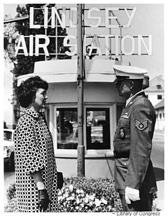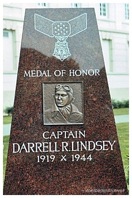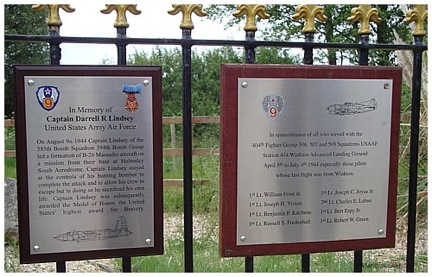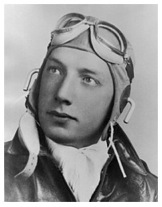Capt. Darrell Lindsey, son of Mr. and Mrs. J. L. Lindsey, formerly of Jefferson and now of Fort Dodge, has been reported missing in action over France. He was a pilot of a Marauder bomber and was on his 50th mission Aug. 9, when he failed to return. Mr. Lindsey was county engineer a number of years ago here and is now maintenance engineer for the state highway commission.
Source: Jefferson Bee, September 12, 1944
![]()
Wins Highest U. S. Award
Mr. and Mrs. J. L. Lindsey, formerly Jefferson residents who have lived in Fort Dodge for a number of years, have received the Congressional Medal of Honor which has been awarded posthumously to their son, Capt. Darrell R. Lindsey, who was killed in action last Aug. 9. He is the second Iowan to receive the nation’s highest decoration for bravery.
Capt. Lindsey was a B-26 Marauder pilot. Flak struck his bomber while he was leading a formation over a railway bridge in France. Although one engine was knocked out, his plane in flames and out of formation, Capt. Lindsey led the bombers over the target and kept control of his plane until the crew bailed out. He went on to crash in flames.
Source: Jefferson Bee, May 22, 1945
![]()
WIDOW RECEIVES HUSBAND’S MEDAL
Fort Dodge, Ia.—(AP)—The widow of one of Iowa’s World War II heroes will receive the Congressional Medal of Honor, August 9.
The formal presentation of the nation’s highest award will be made to Mrs. Evalyn Lindsey at the Presbyterian Church in Fort Dodge.
It will have been just a year after Captain Darrell Lindsey died at the controls of his burning plane in a raid over France. Captain Lindsey stayed at the controls so that fellow crew members might parachute to safety and died as the flaming ship plunged to earth.
Source: Ames Daily Tribune, July 21, 1945
![]()
Mr. and Mrs. Richerson Attend Ceremony for Capt. D. R. Lindsey
Mr. and Mrs. G. C. Richerson were in Ft. Dodge last evening attending a ceremony at the First Baptist Church in which the Medal of Honor, the nation’s highest decoration, was awarded posthumously to Captain Darrell R. Lindsey, son of Mr. and Mrs. J. L. Lindsey of Ft. Dodge. The medal was presented to the bomber pilot’s widow, who now lives at Storm Lake.
Yesterday was the first anniversary of the death of Capt. Lindsey, whose plane exploded after it was hit by flak over France.
Source: Carroll Times Herald, August 10, 1945
![]()
GREATER LOVE HATH NO MAN
Congressman James I. Dolliver delivered an address at Fort Dodge on August 9, on the occasion of the posthumous award of the Congressional Medal of Honor to Captain Darrell R. Lindsey, who died “in the performance of a task above and beyond the call of duty.”
Congressman Dolliver in calling attention to Captain Lindsey’s “sacrifice upon the altar of human liberty,” referred to the fact that six Iowa men have won this highest military award during the present war. He also called attention to the fact that Iowa has 333,076 men and women in service and that there are over 6,700 known Iowans dead. He says Iowa stands twenty-second in population, but is far above that in the number of her sons and daughters in military service. He sated that nine per cent of the population of the country is in the armed forces, with about 14 ½ per cent of the population of Iowa under arms.
Paying a tribute to Captain Lindsey, the Iowa Congressman said he has gone into that “wild blue yonder.” There he has the place reserved for him who makes the last self-effacing gift of his own life for his comrades. God Himself has said so, for the Scripture records:
‘Greater love hath no man than this, that he lay down his life for his friends.’
Source: LeMars Semi-Weekly Sentinel, August 17, 1945
![]()
Camp In Germany Named For Iowa Hero
FRANKFURT, GERMANY (AP)—Two United States military installations in Germany have been renamed in honor of Americans who have lost their lives in the war, army headquarters announced today.
Gersdorf Kaserne, a displaced persons camp at Wiesbaden, henceforth will be known as Camp Lindsey in honor of Capt. Darrell R. Lindsey, of Ft. Dodge, Iowa. When his bomber was hit over France, he forfeited his own chance to escape in order to allow his crew to bail out.
The Neue Kaserne, now used as a constabulary station, will bear the name of Sadowski barracks in memory of Sgt. Joseph J. Sadowski, of Perth Amboy, N.J. Sadowski was killed when he braved a withering hail of fire in an attempt to rescue a comrade trapped in a burning tank.
Source: Ottumwa Daily Courier, March 8, 1947
![]()
Captain Darrell Robins Lindsey
December 30, 1919 – August 9, 1944
Darrell Robins Lindsey, the son of Jesse Lyle Lindsey(1888-1977) and Grace Alice (Puffer) Lindsey (1889-1968), was born in Jefferson, Iowa on December 30, 1919. Darrell graduated from high school in Fort Dodge with the class of 1938. He attended classes at Buena Vista University in Storm Lake for a year before transferring to Drake University in Des Moines.
On January 16, 1942, Darrell enlisted at Fort Des Moines as an aviation cadet. He received his training at Visalia, Lemoore and Victorville Fields in California, winning his pilot's wings and a commission as a 2nd Lieutenant in August of 1942. 2nd Lt. Lindsey trained as a bombardier at Kirtland Field in New Mexico. He was promoted to the rank of 2nd Lieutenant in 1943 and was assigned to the 314th Bomb Squadron at MacDill Field, Florida.
Lt. Lindsey was transferred to Kellogg Field in Michigan in September of 1943 where he was assigned to the 585th Bomb Squadron, 394th Bomb Group (Medium), which was a B-26 Marauder outfit. In December, he was promoted to the rank of Captain and assigned as a flight commander.
The 394th was attached as a part of the Ninth Air Force and was deployed to RAF Boreham, England, on March 11, 1944. Almost immediately the 394th participated in bombing bridges, airfield and the rail system in France, all preparations for the cross-channel invasion of D-Day on June 6, 1944.
On D-Day, the 394th attacked gun positions in Cherbourg, then supported Allied ground units at Normandy by attacking German lines of communication.
The 394th was transferred to RAF Holmsley South in late July in preparation for a move to the continent. On August 7, 1944, they began a 3-day campaign with rail and bridge targets in the Ile-de-France region of Northern France. The entire group received a Distinguished Unit Citation for their work in this campaign.
By this time, Captain Lindsey was a veteran of 45 combat missions. He was well known for his skills as a pilot and for his coolness under fire.
On August 9, 1944, Captain Lindsey was flying as the group leader of 30 aircraft with a mission to destroy the railroad bridge over the Oise River northwest of Paris at L'Isle Adam. The bridge was one of the last standing in the area and was heavily protected by German anti-aircraft units.
The Germans employed many batteries of 88-mm guns which were a major threat to the B-26s that normally bombed from an altitude of 10,000 to 12,000 feet.
During the bomb run, Captain Lindsey's B-26 was heavily damaged. Both the right engine and wing were set afire. Captain Lindsey was knocked out of formation but quickly recovered his place and led the group over their target. He stabilized the B-26 which would allow the crew to safely parachute from the doomed craft.
Upon bail out, the tail gunner was caught on the fuselage and was killed.
Bombardier Jerry Hyson was the last to leave the B-26 while Captain Lindsey kept her from spinning. Hyson shouted that he would lower the landing gear so the Captain could bail out from the nose of the craft. By this time the right wing was totally engulfed in flame and Lindsey knew that lowering the landing gear might throw the plane into an uncontrollable spin. He told Hyson to exit through a waist window. The craft might hold long enough for Hyson's exit. Before Captain Lindsey could leave the cockpit, the wing tank exploded immediately after Hyson bailed out. The B-26 went into a steep dive, hitting the ground in an explosion and a hail of fire.
Bombardier Jerry Hyson broke his ankle when he landed. Because he was Jewish, he removed his dog tags in case he was captured by the Germans. Hyson was rescued by a French underground resistance fighter group who kept him hidden for a month before helping him escape through the Alps into Allied occupied territory.
Captain Lindsey's body was not recovered. He was listed MIA (missing in action) and was presumed killed.
Captain Lindsey's 349th Group received a Distinguished Unit Citation. On May 30, 1945, Captain Lindsey was awarded the Medal of Honor, the only Marauder crew member honored as such in World War II.
During a ceremony at First Presbyterian Church in Fort Dodge, Iowa, on August 9, 1945, Captain Lindsey's widow. Evalyn Scott Lindsay Rhinehart (1919-1992), was presented with his Congressional Medal of Honor by General Robert B. Williams. His citation reads:
"On 9 August 1944, Capt. Lindsey led a formation of 30 B-26 medium bombers in a hazardous mission to destroy the strategic enemy held L'Isle Adam railroad bridge over the Seine in occupied France. With most of the bridges over the Seine destroyed, the heavily fortified L'Isle Adam bridge was of inestimable value to the enemy in moving troops, supplies, and equipment to Paris. Capt. Lindsey was fully aware of the fierce resistance that would be encountered.
Shortly after reaching enemy territory the formation was buffeted with heavy and accurate antiaircraft fire. By skillful evasive action, Capt. Lindsey was able to elude much of the enemy flak, but just before entering the bombing run his B-26 was peppered with holes. During the bombing run the enemy fire was even more intense, and Capt. Lindsey's right engine received a direct hit and burst into flames. Despite the fact that his ship was hurled out of formation by the violence of the concussion, Capt. Lindsey brilliantly maneuvered back into the lead position without disrupting the flight. Fully aware that the gasoline tanks might explode at any moment, Capt. Lindsey gallantly elected to continue the perilous bombing run. With fire streaming from his right engine and his right wing half enveloped in flames, he led his formation over the target upon which the bombs were dropped with telling effect. Immediately after the objective was attacked, Capt. Lindsey gave the order for the crew to parachute from the doomed aircraft. With magnificent coolness and superb pilotage, and without regard for his own life, he held the swiftly descending airplane in a steady glide until the members of the crew could jump to safety.
With the right wing completely enveloped in flames and an explosion of the gasoline tank imminent, Capt. Lindsey still remained unperturbed. The last man to leave the stricken plane was the bombardier, who offered to lower the wheels so that Capt. Lindsey might escape from the nose. Realizing that this might throw the aircraft into an uncontrollable spin and jeopardize the bombardier's chances to escape, Capt. Lindsey refused the offer. Immediately after the bombardier had bailed out, and before Capt. Lindsey was able to follow, the right gasoline tank exploded. The aircraft sheathed in fire, went into a steep dive and was seen to explode as it crashed. All who are living today from this plane owe their lives to the fact that Capt. Lindsey remained cool and showed supreme courage in this emergency."
Captain Darrell Robins Lindsey had been awarded the Purple Heart (posthumously), World War II Victory Medal, nine Air Medals, American Campaign Medal, European-African-Middle Eastern Campaign Medal with three Bronze Service Stars for participation in the Air Offensive Europe, Normandy and Northern France campaigns and Distinguished Unit Citation Emblem.

The Lindsey Air Station, Wiesbaden Air Base in Germany was named in Captain Lindsey's honor in November of 1946, pictured above, with Evalyn Scott Lindsey Rhinehart. The Air Station served as the location of the Headquarters for the United States Air Forces in Europe. It closed in 1993 and the red granite monument was shipped to Jefferson, Iowa where it was placed on the lawn of the Greene County Courthouse. The monument was dedicated to Captain Lindsey on June 12, 1993.

The following day at Buena Vista University, Captain Lindsey's alma mater, dedicated a memorial to him and Ralph Neppel, another Medal of Honor recipient who had attended the university. This monument was donated by Judge Charles Pendleton. The Judge had earlier made a donation in the memory of Evalyn Scott Lindsey Rhinehart who had been killed August 17, 1992 in a motor vehicle accident. Evalyn was the widow of Captain Lindsay and had remarried Dr. Bruce L. Rhinehart (1922-2010), another Buena Vista Alumnus. Together, Judge Pendleton and Dr. Rhinehart founded the Lindsey-Neppel Scholarship at Buena Vista in 1993.
![]()
Bomber pilot is only FD man to earn the Medal of Honor
Capt. Darrell Lindsey went down with his plane;
air station, street were named in his honor
In the months before Darrell Lindsey graduated from Fort Dodge Senior High School in 1938, Adolf Hitler's Nazi legions gobbled up Austria and Czechoslovakia, prompting Europeans to fear their turn might be next.
Those disturbing events seemed too far away to affect the young man whom classmates remembered as an all-around nice guy.
But six years later, Lindsey gave his life to help defeat the Nazis.
He stayed at the controls of a flaming bomber in the air over occupied France, keeping the plane steady so his crew could escape. The plane crashed with Lindsey still aboard.
In 1945, he was posthumously awarded the Medal of Honor.
Lindsey is the only person from Fort Dodge to receive the nation's highest award for military bravery.
"I think he was a true American hero," said Dr. Bruce Rhinehart, of Garden Grove, Calif.
Rhinehart, a Storm Lake native, went to Buena Vista College (today's Buena Vista University) with Lindsey. In 1946, he married Lindsey's widow, Evalyn.
She died in 1992. Since Lindsey had no close living relatives, Rhinehart became a kind of guardian of the fallen pilot's memory. He feels Lindsey should get more recognition locally, but he acknowledged the memory of World War II "diminishes year by year."
There are a few memorials to Lindsey in the area. His portrait and a copy of his Medal of Honor citation are on display in the Fort Museum and Frontier Village in Fort Dodge.
In Jefferson, Lindsey's birthplace, there is a granite marker in front of the Greene County Courthouse which once was at Lindsey Air Station in Germany. And although his body was never found, a bronze military headstone bearing his name is in the family plot at Jefferson Cemetery.
Lindsey's early years
Lindsey was born on Dec. 30, 1919, in Jefferson, the son of Jess and Grace Lindsey. The family moved to Fort Dodge just in time for his senior year of high school.
At that time the high school was in the building at 1015 Fifth Ave. N., which is today's Phillips Middle School.
Del Porter, of Fort Dodge, was also in the class of 1938. He recalled that Lindsey didn't have many friends because he had only been in town for about a year. Porter said the future pilot was a "very, very nice guy."
Lois Ahrens, of Fort Dodge, also graduated with Lindsey.
"He was just very active," she said. "He was a cute guy and full of pizzazz."
After high school, he attended Buena Vista College in Storm Lake for one year. Then he transferred to Drake University in Des Moines.
He enlisted in the Army Air Force on Jan. 16, 1942, a little more than a month after the attack on Pearl Harbor.
Lindsey completed flight training at a succession of bases in California and New Mexico. After earning his pilot's wings, he was stationed at bases in Florida and Michigan.
In February 1944, he was dispatched to Europe.
Lindsey in combat
The pilot was promoted to captain and assigned to the 585th Bombardment Squadron, part of the 394th Bombardment Group. He flew his first combat mission on March 23, 1944.
His 46th and final mission came on Aug. 9, 1944. The target that day was the L'Isle Adam railroad bridge over the Seine River northeast of Paris. American commanders wanted the bridge destroyed so the Germans couldn't use it to move troops toward the Allied armies advancing across France. Lindsey led the mission, flying a B-26 Marauder two-engine bomber.
As the flight of 30 bombers approached the bridge, the Germans opened fire with several anti-aircraft guns. The right engine of Lindsey's plane was hit. The blast knocked the plane out of the formation and set the engine on fire.
Lindsey got the plane under control and maneuvered back into the lead position even as the flames began spreading across the right wing. After the bombs were successfully dropped on the bridge, Lindsey ordered the crew members to bail out. He didn't follow them.
The Medal of Honor citation at the Fort Museum and Frontier Village describes what happened next.
"With magnificent coolness and superb pilotage, and without regard for his own life, he held the swiftly descending airplane in a steady glide until the members of the crew could jump to safety," the document states.
Just after the last crew member bailed out, one of the plane's fuel tanks exploded. The whole plane was engulfed in flames and plunged to the ground.
Three of his crew members who made it back to Allied lines described Lindsey's heroics.
The Medal of Honor was presented to Evalyn Lindsey during an Aug. 9, 1945, ceremony at First Presbyterian Church in Fort Dodge. At the time, the church was located at First Avenue South and Eighth Street.
Later, an Air Force facility in Wiesbaden, Germany, was named Lindsey Air Station in honor of the pilot. A street at the now closed Kincheloe Air Force Base in Michigan was also named after him.
A photo of Lindsey is displayed at the Ardennes American Cemetery and Memorial in Liege, Belgium. Porter, who is a World War II veteran, found that photo by accident during a 1999 visit.
"I just couldn't believe it," Porter said, recalling the surprise of finding the pilot's photo.
He also found Lindsey's name engraved in gold letters on a wall of a building at the cemetery in Belgium.
Source: The Messenger, Fort Dodge, Iowa, by Bill Shea, November 11, 2008
![]()
Holmsley plaque honours American pilot hero
A war hero who sacrificed his life to save others was remembered at a New Forest airfield over the weekend. After an appeal for funds earlier in the year, the Friends of New Forest Airfields raised enough cash for the public memorial to Captain Darrell R. Lindsey at Holmsley.
Captain Lindsey won a posthumous Medal of Honour, the United States’ highest award for bravery, after flying from RAF Holmsley in the summer of 1944. The US airman led a formation of B-26 Marauder aircraft on a mission from their base at Holmsley South Aerodrome on August 9, 1944, staying at the controls of his burning bomber to complete the attack and allow his crew to escape, sacrificing his own life.
The plaque erected at the memorial on Monday, Memorial Day in the US, is the first honouring an individual at any of the airfield sites. Between 1942 and 1944 an estimated 30,000 American airmen from both the eighth and ninth army air forces served on the New Forest Airfields. The greatest concentration of these forces was between April and August 1944 as ninth airforce units operated in support of Operation Overlord, the Allied invasion of Normandy and the Liberation of western Europe.
Veterans of the 394th bomb group were present at the ceremony with Al Momme, vice-president of the association and veteran of the 394th Bomb Group conducting the unveiling and dedication. The bugle call Taps was sounded at 3 p.m. by teenager Robert Shaw along with a salute by the flags with the two standard bearers from Christchurch Air Training Corps.
John Levesley from the Friends of New Forest Airfields said: "It was a poignant afternoon. Around 100 people turned up for the ceremony which was great. One of the most touching things about it was the presence of the youngsters there – our bugle player and the two standard-bearers."
Captain Darrell Robbins Lindsey & U.S.A.A.F. Memorial
New Forest National Park, Hampshire, England
Dedicated on May 31, 2010

INSCRIPTION (Left): "In Memory of Captain Darrell R. Lindsey, United States Army Air Force. On August 9th 1944 Captain Lindsey of the 585th Bomb Squadron 394th Bomb Group led a formation of B-26 Marauder aircraft on a mission from their base at Holmsley South Aerodrome. Captain Lindsey stayed at the controls of his burning bomber to complete the attack and to allow his crew to escape but in doing so he sacrificed his own life. Captain Lindsey was subsequently awarded the Medal of Honor, the United States' highest award for Bravery.
INSCRIPTION (Right): In remembrance of all who served with the 404th Fighter Group 506, 507 and 508 Squadrons U.S.A.A.F. Station 414 Winkton Advanced Landing Ground April 5th to July 4th 1944, especially those pilots whose last flight was from Winkton.
1st Lt. William Frost Jr. |
1st Lt. Joseph C. Joyce Jr. |
1st Lt. Joseph H. Vivian |
2nd Lt. Charles E. Labeo |
1st Lt. Benjamin F. Kitchens |
1st Lt. Bert Espy Jr. |
1st Lt. Russell S. Fredenhall |
1st Lt. Robert W. Green |
Source: The Daily Echo, Bournmouth, England, by Katie Clark, June 2, 2010
![]()


